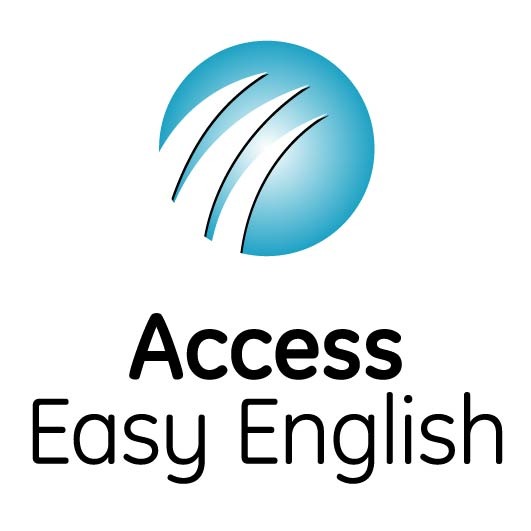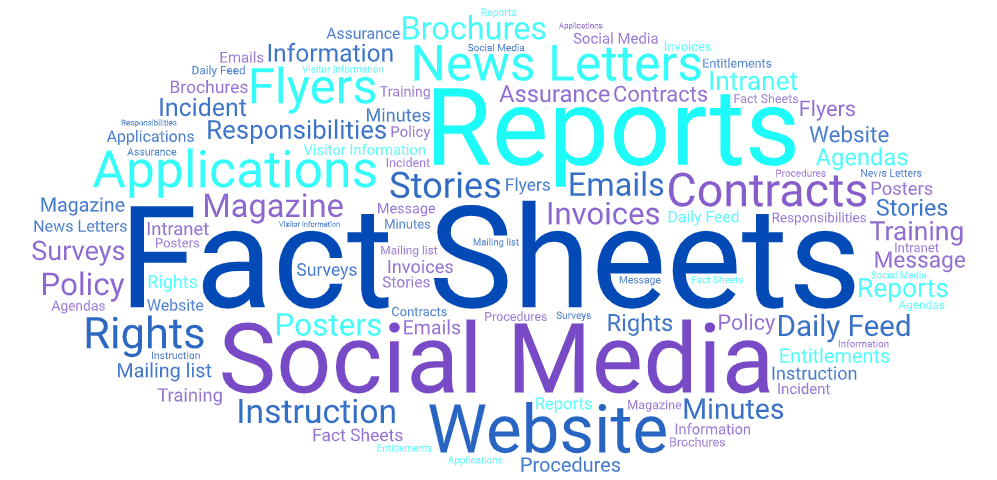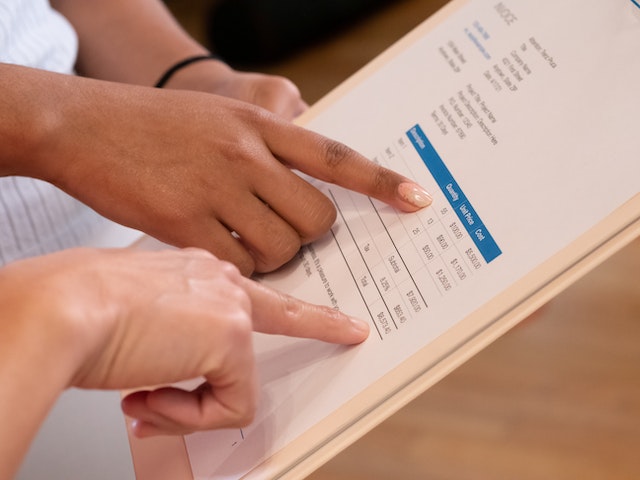About Easy English
What is Easy English?
It is written information for people with low literacy.
This is 44% of the adult (16- 65 years) Australian population. OECD, 2013- 2019, ABS, #4228. This data excludes rural and remote Aboriginal people and people who live in institutions.
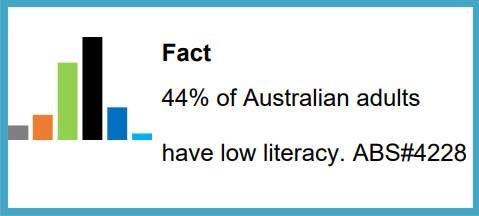
Easy English will
Write in the audience’s everyday words.
Use simple sentence structure.
Support the messages with meaningful and clear images.
Use effective layout.
Have functional consumer reviews.
Is best practice for people with low literacy.
Who can benefit?
Everyone can benefit. Some people can benefit more.
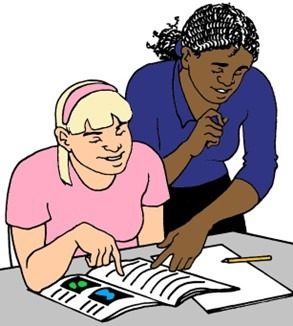


It may be people with
- acquired disabilities. Eg: after a stroke or car accident, head injury, or dementia
- lifelong disabilities. Eg: someone with Down Syndrome, Intellectual Disability, Cerebral Palsy or Autism
- psychiatric or mental illness
- dyslexia. This is a person who has difficulty reading and understanding the written word
- poor educational outcomes
- early school leavers
- older people
- Aboriginal and Torres Strait Islander people
- different cultural backgrounds. Eg: a person who speaks English as a second language
- hearing impairment and/or people from the Deaf community.
Think about people who are
- sick or ill
- time poor
- stressed
- caring for other people.
It may be
- Australians visiting other parts of Australia, or international tourists
- people on working visas
- people on student visas
- migrants
- refugees.
What can you write in Easy English?
Any written content can be developed in Easy English. Think about customers and staff.
And then there is Digital Literacy……
Don't assume that each person
- Has access to the internet
- Can locate content on websites and Apps
- Can read, understand and action any task.
What effect do you think
- Low literacy has on a person’s ability to access and read your website or Apps?
- Low digital literacy, which may be a person with adequate literacy skills, has on a person’s ability to access and read your website or Apps?
Go to Digital Literacy and Easy English. Click here.
Think about what you currently write for the public
Here are a few ideas to think about.
- Fact sheets
- Instructions
- Information sheets
- Letters
- Invitations
- Contracts
- Flyers
- Brochures
- Posters
- Surveys
- Customer feedback
- Reports
- Discussion papers
- Consultations
- Procedures
- Policies
- Agendas & Minutes
- Training materials & Handouts
- Consumer reports
- Invoices & receipts
- PowerPoints
- Web pages
- Social media
- Apps
- Emails
- Online chat
- Text message reminders
- Signs.
What must your staff be able to read, understand & use?
- Instruction sheets – How to guides
- Safety instructions
- Daily task list
- Meeting agendas and minutes
- Policy and Procedures
- Appointment letters
- Individual contracts
- Annual Leave, Sick Leave and Holiday Leave Entitlements
- Salary Packaging
- Intranet and Internet
- Rights and Responsibilities
- Emails
- Daily reports
- Incident reports
- Quality Assurance
- Job advertisements
- Job descriptions.
What else do you need to add to this list?
This blog talks further about literacy and numeracy needs in the workplace.
Work Safety
Think about the chemical make up for cleaning products and materials development, safety gear to be worn, warning signs & procedures. Can each person read and understand them enough to know how to mix them, how to use them and how to manage if there is a spillage? There are first aid manuals, emergency plans and safety procedures, such as for lifting, working at heights, working below ground, under powerlines or on roads. What are the rules about driving, or driving long distances? Entitlements and assessments such as OH&S tests, forklift licences and complaints procedures can be difficult to understand. What else can you think of to make your workplace safe? These need to be in Easy English.Health
Each person is expected to be self-managing their our own health journey.
But Australian government data and the World Health Organisation (WHO) are aware only 2 in 5 Australian adults have the health literacy skills to be able to adequately engage in health information. It is a worldwide issue, and not only an Australian problem.
Health literacy is about
- The policies and procedures each organisation has
- The way staff interact with each person and the environment this occurs in
and
- The individual's own health literacy.
As a speech pathologist, Cathy can support the development of Easy English, and also work with your community to better use effective communication strategies to improve communication interactions.
It may be information about illnesses, mental health issues, admissions procedures, and consent forms.
It may be parents searching for information on childhood illnesses and vaccinations.
Health information is not only an overview fact sheet or brochure, but the same content as any person with adequate literacy has to make choices and decisions about their own health – like reading nutritional information on food packets.
Health insurance is very complex to understand. Do you know what your Health insurance package contains? What are your co-payments? What are your gap payments? What are your entitlements?
What health information do people need to know? Let’s plan and work together to develop it in Easy English.
Legal information
Very few people can read and understand the way laws are written. Less than 5% of the adult Australian population have the literacy skills to read complex legal information to know what it means and the effects of that information.
How do people learn about any law? It may be a council bylaw about dog parks, new road speed limits, property issues or permits to go fishing. Unless information is written so each person can read and understand it, and know what it means for them, they are more likely to break the law. They don’t mean to do that.
People have the right to know about and understand about everyday legal information such as their phone contract, house mortgage contracts, rental contracts or Will.
What do laws mean to the consumer, such as access to services & complaints procedures?
More broadly in the legal and Courts system, it includes any time someone comes into contact with the legal system, from first police contact, making a statement as a witness, victim or perpetrator, court letters, solicitor letters, directions for community based orders, bail or prison terms etc.
Financial information
Being able to take in financial information and know what to do with it requires a mix of literacy and numeracy skills. Making this information easier to understand helps people make payments correctly and on time, and make informed choices about how they use their money.
Bills for water, electricity or credit cards are financial information. Superannuation, house & car insurance, health insurance, builders’ contracts, mortgages, rental leases are more complex examples of financial information. Add to this your workplace contract or workplace agreement and salary packaging. Reading your fortnightly payslip and understanding it goes into your bank account on XX day, so you can access it, requires financial literacy. Understanding about gap fees on any of your insurance or childcare, and understanding and planning/budgeting your monthly or quarterly payments, is all part of financial information. It is anything to do with banking from how to open a bank account, providing your 100 points identification, knowing and planning for your monthly fees and how to avoid them. It is understanding about GST when it is not on an invoice, but added to the total. It is also being able to budget for items such as a meal out or take away versus buying a week of groceries. Pay day lenders, lay by, using a credit card or saving and paying outright all require financial literacy. Each has rules which the customer has the right to receive, read and understand what it means for the product they are using. What else needs to be in Easy English?
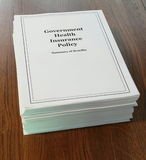
Government information
All levels of government produce many different documents for the public.
Think about application forms, eligibility criteria, appointment letters, release of information, fact sheets about the department or information packs, grievance procedures, feedback and complaints, strategic plans, annual reports, department reports and committee reports.
What about cancellation of services and change of access to services and any fees or co-payments?
Government departments ask for information from the public. There are discussion papers, and committee key criteria to address. Do you know your Rights and Responsibilities in your interactions with a government department?
The NDIS is a complex government agency where service providers as well as the NDIS must make their content accessible in a way that people need and understand. The UNCRPD (United Nations Convention on the Rights of Persons with Disability), Article 21 states this. Australia is a signatory to the convention.
All this information needs to be available in Easy English.


Education information
School reports, school newsletters, permission forms for excursions, release of private information, meeting requests with teachers – all these written require information needs.
People with more limited literacy have shown they do participate more in this process when they are engaged in the content via the use of Easy English. Recent examples demonstrate clearly, items such as excursion or permission forms are signed and returned to staff more often, more quickly and with the right information for staff.
Read our blog on the use of digital literacy and COMPASS ™ in Victorian schools and the challenges for all families in accessing their child’s education.
Then there are the students who do not have the literacy to participate in their educational journey. The most recent PISA reading data report this to be 20% of 14 & 15 year old Australian children. Read our blogs on this here and here.
How do these students continue to participate in their education?
All students have the right to access their education in a way that is meaningful to them.
An assessment matrix and all topic content can be developed into Easy English
What would you like to see written in Easy English in your school or educational facility or day program?
Leisure and participation in your community
We are all tourists in our own communities. Then there are intrastate and interstate and international visitors. How do people find your event, activity or place? Every day we read information about activities and events in our community. Increase the number of people who come to your events by having information written in Easy English. Think about promotional brochures and posters, program descriptions, ticket purchases, car parking and other access information as well as cancellation fees. People need to know the rules to be able to play a sporting activity or other event. Make sure these are available in Easy English too. Then there are day to day activities in the home; how to put a piece of furniture together, learn to use a new appliance and recipes. Different people want to know more about daily news stories and events and/or the stories from magazines. Without access to Easy English, up to 44% of the community may never know what great activity your business offers. From an income point of view it is extraordinary that without changing the way a business writes their content they could be missing such large amounts of customers. Having travelled recently, it is amazing how many brochures about activities you can pick up. Why? Because tourist operators do not rely on all visitors having access to the internet, or perhaps to remind travellers what they offer is better than the place next door. They need to stand out. I just wish you could still book a ticket without always needing to go on a website or via email. Read more about digital literacy here. What do you think needs to be in Easy English in leisure and community activities?Write in Easy English to improve your website accessibility.
Check out Easy English website examples:
